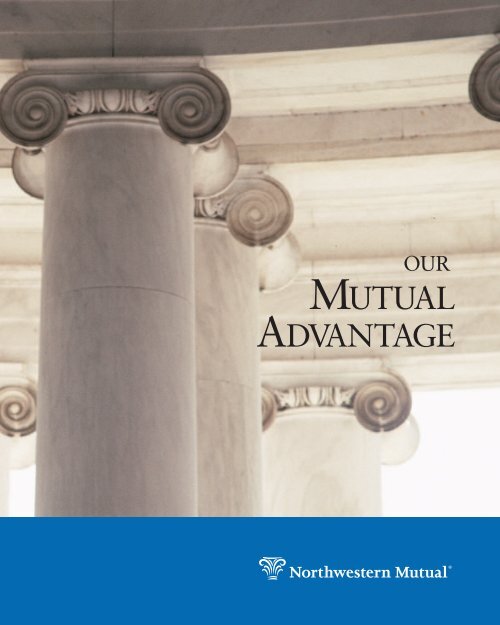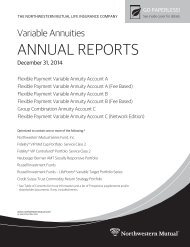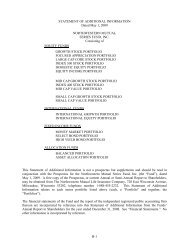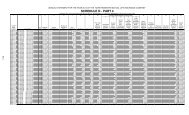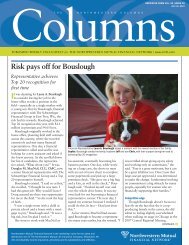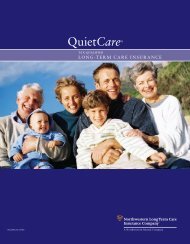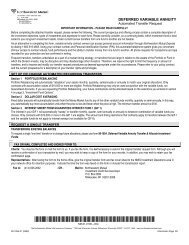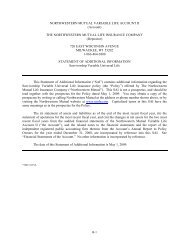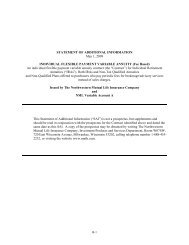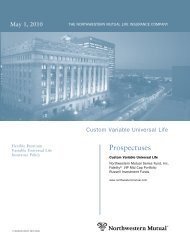mutual advantage. - Northwestern Mutual
mutual advantage. - Northwestern Mutual
mutual advantage. - Northwestern Mutual
You also want an ePaper? Increase the reach of your titles
YUMPU automatically turns print PDFs into web optimized ePapers that Google loves.
OUR<br />
MUTUAL<br />
ADVANTAGE
Of all the reasons policyowners and clients value<br />
<strong>Northwestern</strong> <strong>Mutual</strong> as their partner on the path to<br />
financial security, one is paramount. It’s often called the<br />
company’s “<strong>mutual</strong> <strong>advantage</strong>.”<br />
As a <strong>mutual</strong> life insurance company,<br />
<strong>Northwestern</strong> <strong>Mutual</strong> did not invent the<br />
concept of “<strong>mutual</strong>ity.” Over time, however,<br />
and continuing today, the company has become<br />
what many point to as the pre-eminent example<br />
of the power inherent in the <strong>mutual</strong> form of<br />
corporate governance.<br />
Indeed, <strong>Northwestern</strong> <strong>Mutual</strong> offers dramatic<br />
evidence that a company governed by <strong>mutual</strong><br />
values can be, in its field, best in the world. 1<br />
The <strong>mutual</strong> structure of <strong>Northwestern</strong> <strong>Mutual</strong><br />
allows the company to act differently than<br />
most publicly traded stock companies,<br />
which typically must split their focus between<br />
customers and shareholders. As a <strong>mutual</strong>,<br />
<strong>Northwestern</strong> <strong>Mutual</strong> has no shareholders.<br />
The company’s <strong>mutual</strong> structure allows it to<br />
focus solely and directly on its customers.<br />
Customers buying life insurance, disability<br />
insurance and annuities become members the<br />
instant they purchase their policies.<br />
In the typical stock company, profits go<br />
to shareholders. In contrast, <strong>Northwestern</strong><br />
<strong>Mutual</strong> is more like a cooperative. After<br />
setting aside a safe margin for reserves and<br />
surplus each year, the company returns what<br />
would otherwise be “profits” to its participating<br />
policyowner members in the form of dividends.<br />
Customers of our subsidiary, <strong>Northwestern</strong><br />
Long Term Care Insurance Company, hold<br />
policies that have the potential to pay<br />
dividends in the future if actual experience<br />
proves to be more favorable than<br />
pricing expectations.<br />
In other words, <strong>Northwestern</strong> <strong>Mutual</strong>’s<br />
<strong>mutual</strong> structure brings into alignment<br />
the interests of both policyowners and<br />
company. For policyowners, that’s an<br />
enormous “<strong>mutual</strong> <strong>advantage</strong>.”<br />
There are others. As a <strong>mutual</strong>, the company can<br />
focus the investments in its general account over<br />
the long term. That’s another reason why respected<br />
experts praise the company’s <strong>mutual</strong> structure<br />
and values as the underpinnings for its “strong<br />
competitive position” 2 in which “policyowner<br />
value and security are the paramount focus.” 3<br />
As practiced by <strong>Northwestern</strong> <strong>Mutual</strong>,<br />
however, <strong>mutual</strong>ity extends well beyond these<br />
basic <strong>mutual</strong> <strong>advantage</strong>s. The customer<br />
benefits of our <strong>mutual</strong>ity are manifested in<br />
four key values—<br />
• Doing what’s right for policyowners<br />
and other clients<br />
• Building long-term relationships to meet<br />
their needs<br />
• Building and preserving financial strength<br />
• Offering world-class products and expert<br />
guidance that address changing needs over<br />
a lifetime.<br />
We invite you to explore these values on the<br />
following pages, to see how our brand of<br />
<strong>mutual</strong>ity sets us apart. We believe you will<br />
find it to be … a <strong>mutual</strong> <strong>advantage</strong>.<br />
1<br />
Fortune magazine, Global Most Admired, March 7, 2005<br />
2<br />
Moody’s Investors Service, March 2005<br />
3<br />
Standard & Poor’s, July 2004<br />
1
THE RIGHT THING<br />
Ever since <strong>Northwestern</strong> <strong>Mutual</strong> was founded<br />
in 1857, generations of company leaders have<br />
used a single test in making corporate decisions:<br />
“Is what we’re doing in the best long-term<br />
interest of our policyowners?”<br />
This steadfast customer focus requires a<br />
special kind of “purposeful fairness.” It has<br />
produced a tradition as old as the company—<br />
equitable treatment for all.<br />
<strong>Mutual</strong>ity in practice<br />
Elsewhere in life insurance, inequitable<br />
treatment of some over others became<br />
commonplace. Many companies tried to<br />
attract new customers by offering special<br />
or improved benefits not available to<br />
current policyowners.<br />
This is not the practice at <strong>Northwestern</strong><br />
<strong>Mutual</strong>, where the <strong>mutual</strong>ity that sets us apart<br />
extends to our practice of operating on our<br />
policyowners’ behalf in very tangible ways,<br />
including pricing, underwriting, claims,<br />
service—and more.<br />
‘Retroactive’ benefits<br />
One practical example is <strong>Northwestern</strong><br />
<strong>Mutual</strong>’s approach to “retroactivity.”<br />
As new and enhanced benefits to<br />
<strong>Northwestern</strong> <strong>Mutual</strong> life and disability<br />
insurance products become available, existing<br />
policyowners are given the opportunity to<br />
acquire them, whenever possible and practical.<br />
“… It (is) …. pre-eminently the<br />
policyowner’s company.”<br />
- Executive Committee of the<br />
Board of Trustees, 1888<br />
“The company is a <strong>mutual</strong> organization<br />
in the strictest and best<br />
sense … This is a company<br />
operated by the policyholders<br />
and for the best interests of<br />
the policyholders.”<br />
- Examination of the Wisconsin Insurance<br />
Department, 1905<br />
“Our beliefs are not the easy way—<br />
but we think they are the right way.<br />
We do not propose to change our<br />
philosophy of <strong>mutual</strong>ity and fairness<br />
to all policyowner-members.<br />
This company is different.”<br />
- Francis Ferguson, President and CEO,<br />
<strong>Northwestern</strong> <strong>Mutual</strong>, 1973<br />
“<strong>Northwestern</strong> <strong>Mutual</strong> executives<br />
use a simple yardstick to measure<br />
every business venture, every<br />
business decision, every contract:<br />
Is it in the best interest of the<br />
2.8 million policyowners …?”<br />
- Best’s Review, March 1999<br />
2
Throughout the years, the company has<br />
offered several life insurance amendment<br />
programs, or “Updates,” which involved<br />
massive efforts to extend new <strong>advantage</strong>s<br />
to existing policyowners. In one program<br />
alone, <strong>Northwestern</strong> offered life insurance<br />
policyowners $4.5 billion of additional<br />
insurance at no increase in premium.<br />
Forbes magazine recognized the unusual nature<br />
of this commitment: “The tactics of Milwaukeebased<br />
<strong>Northwestern</strong> <strong>Mutual</strong> … are a little bit<br />
unconventional. It has a habit of attracting new<br />
customers by giving away money to old ones.” 4<br />
4<br />
Forbes, “Shopping for Life,” February 22, 1988<br />
“We believe <strong>mutual</strong>ity provides<br />
<strong>Northwestern</strong> <strong>Mutual</strong> with great<br />
competitive <strong>advantage</strong> and is one of<br />
the factors that has enabled the<br />
company to remain financially strong<br />
and to keep decisions focused on<br />
longer term implications (rather than<br />
on reported quarterly earnings.)”<br />
- Report of the Policyowners’ Examining<br />
Committee, 2001<br />
“Our <strong>mutual</strong> company has prospered<br />
for 148 years by pursuing a model of<br />
long-term commitment to policyowners.<br />
We believe the company, through its<br />
talented employees, will continue this<br />
tradition...a present of promises met<br />
and a future of promises delivered.”<br />
- Report of the Policyowners’ Examining<br />
Committee, 2004<br />
“The commitment to do “the right<br />
thing” for policyowners, supported by<br />
the <strong>advantage</strong>s of having a <strong>mutual</strong><br />
structure rather than a publicly traded<br />
stock structure, provides a common<br />
value system that drives and shapes<br />
every aspect of <strong>Northwestern</strong><br />
<strong>Mutual</strong>’s business.”<br />
- Report of the Policyowners’ Examining<br />
Committee, 2002<br />
“Because of its ongoing commitment<br />
to <strong>mutual</strong>ity, policyowner value comes<br />
first as opposed to shareholder value.<br />
As a result, policyowners receive<br />
demonstrably better economic value<br />
in two ways: industry-leading dividends<br />
and the promise that the company<br />
will be there when claims come due.”<br />
- Report of the Policyowners’ Examining<br />
Committee, 2003<br />
3
LONG-TERM VIEW<br />
Steeped in <strong>mutual</strong>ity, <strong>Northwestern</strong> <strong>Mutual</strong><br />
enjoys unusual customer loyalty and is<br />
commonly ranked as a leader in customer<br />
satisfaction. 5 Policyowners not only keep their<br />
policies, they keep returning for more. In a<br />
typical year, more than half of life insurance<br />
purchases are made by existing—and satisfied—<br />
customers. 6 The key to encouraging such<br />
loyalty isn’t only how we attract customers<br />
initially, it’s what we do to keep them.<br />
“Going forward, we’re going to continue<br />
to drive home the value proposition of<br />
excellent product value and long-term<br />
customer relationships built by our<br />
financial representatives.”<br />
- Ed Zore, President and CEO, <strong>Northwestern</strong> <strong>Mutual</strong>,<br />
Leaders magazine, 2002<br />
Whether it’s product development, investment<br />
selection or other activities that contribute to<br />
our lifetime relationships, <strong>Northwestern</strong><br />
<strong>Mutual</strong> takes the long view—with an eye<br />
toward lasting strength and an enduring<br />
“<strong>mutual</strong> <strong>advantage</strong>.”<br />
One key to building long-term relationships<br />
is to provide superior long-term product<br />
value. <strong>Northwestern</strong> <strong>Mutual</strong> has and<br />
continues to return outstanding dividend<br />
payouts. 7 The company’s consistent results<br />
are powered by careful underwriting,<br />
vigilant expense control and prudent but<br />
productive investment practices.<br />
Superior value<br />
The company provides superior value, in part,<br />
through its general-account investment<br />
strategy. This strategy emphasizes long-term<br />
investments, which typically outperform shortterm<br />
investments.<br />
The result has been that policyowners receive<br />
steady, stable, excellent value. That’s why<br />
<strong>Northwestern</strong> <strong>Mutual</strong> pays far more individual<br />
life insurance dividends each year than any<br />
other company ($3.9 billion in 2005). 8<br />
Lasting relationships<br />
It’s often said that <strong>Northwestern</strong> <strong>Mutual</strong><br />
already has what many others in financial<br />
services hope to create—lasting customer<br />
relationships built on confidence and trust.<br />
Building such relationships is truly a team<br />
effort. And this team effort begins with<br />
<strong>Northwestern</strong> <strong>Mutual</strong>’s nationwide field force<br />
of financial representatives.<br />
<strong>Northwestern</strong> <strong>Mutual</strong> has long been<br />
committed to maintaining a well-trained corps<br />
of financial representatives who make this<br />
profession their lifelong career. Rooted in the<br />
<strong>Northwestern</strong> <strong>Mutual</strong> culture, our financial<br />
representatives are:<br />
• Trained to develop lifetime clients rather than<br />
one-time customers; to address long-term<br />
needs and to help clients build sound plans<br />
aimed at ensuring their financial security.<br />
• Committed to providing service throughout<br />
their clients’ lifetimes.<br />
• Attracted to and joined with <strong>Northwestern</strong><br />
<strong>Mutual</strong> through a bond of common values.<br />
4<br />
5<br />
American Customer Satisfaction Index, February 2005. Produced by the Stephen M. Ross Business School at the<br />
University of Michigan in partnership with the American Society for Quality and international consulting firm, CSI Group.<br />
6<br />
Source: <strong>Northwestern</strong> <strong>Mutual</strong><br />
7<br />
For a fuller explanation of dividends, see inside back cover<br />
8<br />
Source: A.M. Best Company. Data calculated by <strong>Northwestern</strong> <strong>Mutual</strong>
“Since some 54 years<br />
ago, when I took out a<br />
small life policy, I have<br />
been very impressed<br />
with the way your<br />
Trustees have guided<br />
your company, and<br />
more impressed with<br />
how you deal with your<br />
policyowners.”<br />
- California policyowner, 1993<br />
Listening is key<br />
Listening to clients has been a historic company<br />
strength. One tradition that keeps us sensitive<br />
to customer needs is our Policyowners’ Examining<br />
Committee. Since 1907, the company’s Board<br />
of Trustees has annually named a group of<br />
three to five policyowners to produce an<br />
independent and unrestricted evaluation of<br />
company operations, management and strategic<br />
plans. The committee’s report is published<br />
each year in our Annual Report. Important<br />
improvements in company structure and<br />
operations have resulted from this unique<br />
annual “customer check-up.”<br />
“The Policyowners’<br />
Examining Committee<br />
is an extraordinary thing.<br />
I don’t know of any<br />
company, insurance or<br />
not, that opens up its<br />
entire shop, in intimate<br />
detail, to its customers.<br />
The ultimate winners<br />
are the policyowners.”<br />
- George Dickerman,<br />
Policyowner, Trustee and<br />
former member, Policyowners’<br />
Examining Committee,<br />
Chairman (Retired) Spalding<br />
Sports Worldwide<br />
“Over the years, we have<br />
always thought in terms<br />
of the individual rather<br />
than the mass and have<br />
consciously built toward<br />
a personal relationship<br />
between the policyholder,<br />
the agent and the<br />
company.”<br />
- Edmund Fitzgerald, President<br />
and CEO, <strong>Northwestern</strong><br />
<strong>Mutual</strong>, 1958<br />
5
FINANCIAL STRENGTH<br />
Financial strength is and has been integral to<br />
<strong>Northwestern</strong> <strong>Mutual</strong>’s vision for<br />
policyowners and clients. Our <strong>mutual</strong>ity sets<br />
us apart financially.<br />
On a basic level, of course, financial<br />
strength is an obligation. It arises from our<br />
commitment to policyowners, from the<br />
personal security they entrust with us.<br />
Company founders pioneered a culture of<br />
“…consistently receives the highest marks<br />
from rating agencies, which means it is<br />
fiscally strong enough to outlast you.”<br />
- Worth magazine, Editors’ Choice Award<br />
July/August 2002<br />
scrupulous responsibility for policyowner<br />
funds—to provide superior value and<br />
pay claims promptly on long-term financial<br />
contracts that often remain in force<br />
for decades.<br />
Throughout our history, this attitude and<br />
approach has kept the company on a strong<br />
and solid course during difficult economic<br />
times that rocked many others in the business<br />
world. Clearly, <strong>Northwestern</strong> <strong>Mutual</strong> has<br />
achieved financial strength of major proportions.<br />
Our approach to <strong>mutual</strong>ity, including the<br />
long-term investment strategy and tight focus<br />
on operating fundamentals, helps us maintain<br />
the highest possible financial ratings. 9<br />
6<br />
“<strong>Northwestern</strong> <strong>Mutual</strong> is committed<br />
to retaining its <strong>mutual</strong>ity, which Moody’s<br />
believes can be a competitive<br />
<strong>advantage</strong> in today’s markets.<br />
While stock companies have greater<br />
access to capital, <strong>advantage</strong>s of<br />
remaining a <strong>mutual</strong> company include<br />
extremely competitive returns to<br />
participating policyowners in the<br />
form of dividends and reduced shortterm<br />
scrutiny from outside parties,<br />
permitting the company to take a<br />
longer-term planning horizon (such as<br />
taking <strong>advantage</strong> of favorable longterm<br />
equity market returns to<br />
maintain high policy dividends).”<br />
- Moody’s Investors Service, Rating Analysis,<br />
April 2005<br />
9<br />
Moody’s, Aaa; Standard & Poor’s, AAA; A.M. Best,<br />
A++; and FitchRatings, AAA<br />
“If you find a client with an existing<br />
<strong>Northwestern</strong> <strong>Mutual</strong> Life policy, simply<br />
insist on retention of that policy.<br />
<strong>Northwestern</strong> <strong>Mutual</strong> is, by quite a<br />
margin, the best. So it was in 1955<br />
when I went into the business. So it<br />
will likely be long after I’m dead.”<br />
- James Hunt, Consumer Federation of America<br />
Web site (www.consumerfed.org)<br />
September 28, 2001<br />
“The (insurer financial strength) ratings<br />
reflect <strong>Northwestern</strong>’s market-leading<br />
individual life insurance business, its<br />
extremely strong capitalization and very<br />
strong operating performance. Other<br />
factors include the company’s very<br />
strong and unique investment strategy<br />
and strong liquidity.”<br />
- Standard & Poor’s Insurance Rating Analysis,<br />
July 2004
BUILDING BLOCKS OF MUTUALITY<br />
Superior life insurance value for the policyowner<br />
rests on our ability to produce<br />
outstanding results in these four areas:<br />
• Mortality<br />
• Expenses<br />
• Persistency<br />
• Investments<br />
These four value-producers are building blocks of<br />
<strong>mutual</strong>ity. <strong>Northwestern</strong> <strong>Mutual</strong> excels at all four.<br />
Superior Mortality<br />
A periodic industry study allows <strong>Northwestern</strong><br />
<strong>Mutual</strong> to compare its mortality experience to<br />
the combined mortality of <strong>Northwestern</strong> and<br />
20 of its major competitors. In simple terms,<br />
<strong>Northwestern</strong> <strong>Mutual</strong> policyowners, on average,<br />
tend to live longer.<br />
The comparison below shows the first 15 policy<br />
years, covers all ages, and includes the best<br />
classes of smokers and non-smokers—<br />
the vast majority of <strong>Northwestern</strong> <strong>Mutual</strong>’s<br />
insureds. <strong>Northwestern</strong> <strong>Mutual</strong> has consistently<br />
experienced lower mortality than its<br />
competitors. In the latest study, its mortality<br />
experience was about 35% better than the<br />
intercompany average. Because the average<br />
company pays proportionately more in death<br />
benefits than <strong>Northwestern</strong> <strong>Mutual</strong> does, the<br />
average company has that much less to<br />
return in dividends to surviving policyowners.<br />
We attribute this superiority in mortality to<br />
a field force that seeks out people who live<br />
responsibly, and to a medical and underwriting<br />
staff exceptionally skilled in assessing health<br />
risks. This contributes to superior value for<br />
our policyowners.<br />
Society of Actuaries Comparative Mortality Study<br />
Medical & Paramedical Combined<br />
All Ages, First 15 Policy Years<br />
Intercompany Average<br />
<strong>Northwestern</strong> <strong>Mutual</strong><br />
140%<br />
105%<br />
70%<br />
35%<br />
69-<br />
74<br />
70-<br />
75<br />
71-<br />
76<br />
72-<br />
77<br />
73-<br />
78<br />
74-<br />
79<br />
75-<br />
80<br />
76-<br />
81<br />
77-<br />
82<br />
78-<br />
83<br />
79-<br />
84<br />
80-<br />
85<br />
81-<br />
86<br />
82-<br />
87<br />
83-<br />
88<br />
84-<br />
89<br />
85-<br />
90<br />
86-<br />
91<br />
87-<br />
92<br />
88-<br />
93<br />
89-<br />
94<br />
90-<br />
95<br />
91-<br />
96<br />
92-<br />
97<br />
93-<br />
98<br />
94-<br />
99<br />
95-<br />
00<br />
96-<br />
01<br />
Source: Society of Actuaries Comparative Mortality Studies<br />
Prepared and calculated by The <strong>Northwestern</strong> <strong>Mutual</strong> Life Insurance Company, Milwaukee, WI.<br />
8<br />
140
Low Expenses<br />
The company is noted for its frugality and its<br />
ability to keep costs down. This has been a<br />
hallmark of the company’s management,<br />
decade after decade. It remains a key<br />
competitive <strong>advantage</strong> today—and a key<br />
ingredient of superior value for the customer.<br />
As an example, <strong>Northwestern</strong> <strong>Mutual</strong>’s<br />
expenses, as measured on its principal product<br />
line, have consistently been about one-third<br />
less than the industry average. These expense<br />
savings can provide additional value for policyowners<br />
in the form of dividends and surplus.<br />
Ordinary Life Expenses<br />
as Percent of Premium*<br />
Company** 2000 2002 2004<br />
<strong>Northwestern</strong> <strong>Mutual</strong> 18.6% 17.7% 18.1%<br />
AEGON 25.6 23.5 21.4<br />
Jefferson-Pilot 19.1 21.9 23.2<br />
Manulife Financial (1) 36.5 23.3 23.2<br />
Pacific Life 24.1 23.1 24.3<br />
New York Life 26.2 25.4 24.4<br />
Guardian 30.9 28.3 25.5<br />
Prudential 41.4 25.0 26.6<br />
American Express 26.7 24.2 27.6<br />
Met Life & Affiliates (2) 30.4 28.7 28.5<br />
State Farm 30.5 31.8 28.7<br />
Principal 22.8 26.6 29.7<br />
Lincoln National 49.9 34.5 29.8<br />
Mass <strong>Mutual</strong> 21.7 24.7 32.8<br />
AXA Financial (3) 23.8 22.1 37.3<br />
Industry Average 29.5 26.3 26.3<br />
* Direct premiums, excluding dividends to additions<br />
** Family data<br />
(1) Primary Companies – John Hancock, John Hancock USA<br />
(2) Primary Companies – New England, General American,<br />
Metropolitan Life<br />
(3) Primary Companies – Equitable, MONY<br />
Source: A.M. Best Company, prepared and calculated by<br />
The <strong>Northwestern</strong> <strong>Mutual</strong> Life Insurance Company, Milwaukee, WI.<br />
“Doing what is best for<br />
the policyowner and<br />
creating policyowner<br />
value (rather than<br />
shareholder value)<br />
remains fundamental to<br />
the shared value system<br />
of the organization.”<br />
- Report of the Policyowners’<br />
Examining Committee, 2001<br />
“<strong>Northwestern</strong> <strong>Mutual</strong> …<br />
has become a model of<br />
the life insurance<br />
company that did things<br />
right. <strong>Northwestern</strong> has<br />
stuck to selling<br />
traditional kinds of<br />
policies … makes its<br />
decisions on<br />
conservative standards,<br />
and controls costs<br />
aggressively.”<br />
- The New York Times,<br />
August 30, 1992<br />
“Our character means<br />
108 years of adherence<br />
to principles and<br />
practices that have<br />
produced outstanding<br />
results. Our record of<br />
quality performance<br />
and integrity gives this<br />
company unique<br />
character.”<br />
- Donald Slichter, President and<br />
CEO, <strong>Northwestern</strong> <strong>Mutual</strong>,<br />
1965<br />
9
10<br />
“As it happens,<br />
<strong>Northwestern</strong>, the master<br />
of loyalty, is also famous<br />
for its careful cost management<br />
… yet all of<br />
<strong>Northwestern</strong>’s savings<br />
would not sustain superior<br />
production if they weren’t<br />
reinvested in the delivery<br />
of superior value to<br />
customers and agents,<br />
earning their loyalty in<br />
the process.”<br />
- Frederick Reichheld,<br />
“The Loyalty Effect,” 1996<br />
“A commandment that<br />
flows from our credo is<br />
a policy of aggressive<br />
fairness. We treat all of<br />
our policyowners with<br />
the same thorough<br />
respect.”<br />
- Donald J. Schuenke,<br />
President and CEO,<br />
<strong>Northwestern</strong> <strong>Mutual</strong>, 1988<br />
“Our company has<br />
embraced <strong>mutual</strong>ity for<br />
143 years. But ironically,<br />
today, as more and more<br />
companies abandon the<br />
<strong>mutual</strong> form, the <strong>advantage</strong><br />
of <strong>mutual</strong>ity is finally<br />
getting its rightful<br />
attention. We like being<br />
a <strong>mutual</strong> company.”<br />
- James D. Ericson,<br />
President and CEO,<br />
<strong>Northwestern</strong> <strong>Mutual</strong>, 2000<br />
Excellent Persistency<br />
The third contributor to policyowner value is<br />
persistency, the degree to which policyowners<br />
keep what they have purchased. A low lapse<br />
rate leads to better mortality results,<br />
better cash flow for investments, and a larger<br />
base over which to spread expenses. The latest<br />
available data shows <strong>Northwestern</strong>’s annual<br />
life insurance lapse rate to be almost half the<br />
industry average.<br />
The company also regards its leadership<br />
position in persistency as important to the<br />
consumer for two reasons. First, it is perhaps<br />
the truest measure of customer satisfaction—<br />
people voting with their dollars, so to speak.<br />
And secondly, persistency is an indicator that<br />
the products were properly bought—and<br />
properly sold—in the first place. People keep<br />
the policies in force for the simple reason that<br />
the products are filling a real need.<br />
Lapse Ratio by Amount Combining<br />
New Business & Inforce Business<br />
Company* 2000 2002 2004<br />
<strong>Northwestern</strong> <strong>Mutual</strong> 4.5% 4.0% 3.9%<br />
American Express 6.4 4.4 4.3<br />
Prudential 6.8 7.8 5.0<br />
Mass <strong>Mutual</strong> 5.9 5.4 5.1<br />
New York Life 7.0 6.5 5.7<br />
Lincoln National 10.0 8.7 5.7<br />
Principal 6.4 6.8 6.0<br />
Manulife Financial(1) 5.8 6.4 6.3<br />
State Farm 8.1 7.6 6.7<br />
Met Life & Affiliates (2) 8.2 8.2 6.8<br />
Pacific Life 4.8 7.7 7.2<br />
Guardian 6.2 6.4 7.5<br />
Jefferson-Pilot 8.8 9.0 7.7<br />
AXA Financial (3) 7.3 7.9 7.8<br />
AEGON 8.1 7.9 8.9<br />
Industry Average 8.6 8.6 7.1<br />
* Family data<br />
(1) Primary Companies – John Hancock, John Hancock USA<br />
(2) Primary Companies – New England, General American,<br />
Metropolitan Life<br />
(3) Primary Companies – Equitable, MONY<br />
Source: A.M. Best Company, prepared and calculated by<br />
The <strong>Northwestern</strong> <strong>Mutual</strong> Life Insurance Company, Milwaukee, WI.
High-Quality Investment Portfolio<br />
The final building block of superior value<br />
and of our unique brand of <strong>mutual</strong>ity is how<br />
we manage our general-account investment<br />
portfolio. <strong>Northwestern</strong> <strong>Mutual</strong> invests in all<br />
the major asset classes and market sectors,<br />
maintaining a diversified portfolio that blends<br />
fixed income and equity investments.<br />
The company is opportunistic in investment<br />
activity and value-oriented in its investment<br />
approach. It can take a long-term perspective<br />
and in some cases can be more aggressive<br />
with portions of its investment portfolio.<br />
This strategy allows <strong>Northwestern</strong> <strong>Mutual</strong> to<br />
maximize total returns with reduced volatility<br />
in an effort to increase investment income and<br />
create additional value for policyowners. 10<br />
Small wonder that observers refer to this<br />
competitive <strong>advantage</strong> as “the power of<br />
the portfolio.”<br />
4<br />
96.3<br />
85.0%<br />
15.0%<br />
Public Bonds &<br />
Preferred Stock 45.1%<br />
3.8%<br />
Private Bonds &<br />
Preferred Stock 16.9%<br />
Private Equities<br />
& Subsidiaries 3.1%<br />
7.8%<br />
5.0%<br />
18.3%<br />
Source: <strong>Northwestern</strong> <strong>Mutual</strong><br />
10<br />
For a fuller explanation of the investment portfolio, see <strong>Northwestern</strong> <strong>Mutual</strong>’s brochure “The Power of the Portfolio”<br />
11
MEETING CHANGING NEEDS—FOR LIFE<br />
<strong>Northwestern</strong> <strong>Mutual</strong>’s world-class insurance<br />
products result from a vision and passion<br />
to be “simply the best” in quality and value.<br />
We have always aimed to—<br />
• Provide superior products<br />
• Avoid fads and gimmicks<br />
• Upgrade our policies in both the scope<br />
of coverage and ability to provide better<br />
benefits at lower costs.<br />
“This insurance and financial firm has zero<br />
new-economy glamour, and that’s just fine.<br />
It’s only gaining market share, boosting<br />
sales, and successfully retaining its topperforming<br />
sales agents.”<br />
- Sales and Marketing Management,<br />
#1 Sales Force: Co-Winner,<br />
July 2001<br />
In recent decades, policyowners have brought<br />
to us a broader range of financial needs.<br />
<strong>Northwestern</strong> <strong>Mutual</strong> has answered with<br />
more diverse products and services. While<br />
keeping our focus on world-class insurance,<br />
we’ve also added a careful selection of related<br />
financial products.<br />
The <strong>Northwestern</strong> <strong>Mutual</strong> Financial Network<br />
These financial products are presented to<br />
customers in a coordinated way through the<br />
<strong>Northwestern</strong> <strong>Mutual</strong> Financial Network.<br />
The Network, the marketing name for the sales<br />
and distribution arm of <strong>Northwestern</strong> <strong>Mutual</strong>,<br />
includes both the company’s financial<br />
representatives and the financial specialists<br />
who help them meet each client’s unique needs.<br />
The combination of financial representatives<br />
and specialists provide needs-based analysis,<br />
expert guidance and innovative solutions to help<br />
clients improve financial security through—<br />
• Asset and income protection<br />
• Education funding<br />
• Business needs analysis<br />
• Investment services<br />
• Employee and executive benefits<br />
• Retirement solutions and<br />
• Estate analysis<br />
And our “<strong>mutual</strong> <strong>advantage</strong>” thrives. As we<br />
continue to do what’s right for policyowners,<br />
build long-term relationships to meet their<br />
needs, build and preserve financial strength, and<br />
provide expert guidance, we will draw upon the<br />
benefits of the culture and values that have<br />
defined our company over time.<br />
“We have an incredibly high level of integrity and a reputation for doing the right<br />
thing. When I first came here in 1969, we were focused on doing what's right<br />
for the customer, and that remains our priority today.”<br />
- Ed Zore, President and CEO,<br />
<strong>Northwestern</strong> <strong>Mutual</strong>, Leaders magazine, 2002<br />
12
7<br />
Dividends for <strong>Northwestern</strong> <strong>Mutual</strong> policies are distributions of the company’s surplus. They arise when premiums plus<br />
investment income are more than enough to cover company operating expenses (including taxes), claim costs, guaranteed<br />
increases in policy cash values and additions to surplus. Dividends are paid annually to policyowners in proportion to company<br />
earnings on their policies. However, decisions with respect to the determination and allocation of divisible surplus are at the<br />
discretion and sound business judgment of the company’s Board of Trustees. There is no guaranteed specific method or formula<br />
for the determination and allocation of divisible surplus. Accordingly, the company’s approach is subject to change. Also, there<br />
is no guarantee that any dividend will be paid on an individual policy in any given year.<br />
Securities are offered through <strong>Northwestern</strong> <strong>Mutual</strong> Investment Services, LLC, Suite 300, 611 E. Wisconsin Ave., Milwaukee,<br />
Wisconsin, 53202, 1-866-664-7737. NMIS is a member of the NASD and SIPC.
Charts contained in this brochure<br />
were prepared and calculated by<br />
The <strong>Northwestern</strong> <strong>Mutual</strong> Life<br />
Insurance Company, Milwaukee, WI.<br />
The <strong>Northwestern</strong> <strong>Mutual</strong><br />
Life Insurance Company Milwaukee, WI<br />
<br />
www.northwestern<strong>mutual</strong>.com<br />
19-0185 (1002) (REV 0805)


